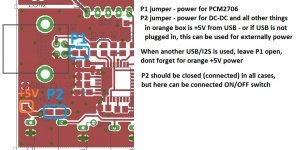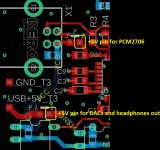Hi Miro,
totally means, one would not need any power from USB host? Nice option. Just for Catherine or even for the current usb dac?
No, I don't know. They do not supply this info. To be honest I just bought it, as Richard had recommended it for his DACs in one of his threads. It has two dedicated clocks (45.. and 49.. MHz - of unknown origin - which could be replaced by known ones). I might compare it to the jlsounds board one day. A pitty, that contrary to my usual practice, both, the AD1862 and the TDA1387 were housed in quickly and this makes it more difficult to just swap the USB thingies.
Probably Richard has got more info about the CM6631A board. There should be a reason for his recommendation. At least for me the sound of the combo is very involving - tight, strong bass, intimate sound, yet a good bit of reverberation, when existing. Good stage, really good voices, more than pretty good pianos and very nice heights. Relaxing sound without any nervousity. Ok, sorry for a lot of o.t.... just to give you my impression, why I asked for the possibility of implementation. And, it is just 20 $ :-D.
Have a good day 🙂
totally means, one would not need any power from USB host? Nice option. Just for Catherine or even for the current usb dac?
No, I don't know. They do not supply this info. To be honest I just bought it, as Richard had recommended it for his DACs in one of his threads. It has two dedicated clocks (45.. and 49.. MHz - of unknown origin - which could be replaced by known ones). I might compare it to the jlsounds board one day. A pitty, that contrary to my usual practice, both, the AD1862 and the TDA1387 were housed in quickly and this makes it more difficult to just swap the USB thingies.
Probably Richard has got more info about the CM6631A board. There should be a reason for his recommendation. At least for me the sound of the combo is very involving - tight, strong bass, intimate sound, yet a good bit of reverberation, when existing. Good stage, really good voices, more than pretty good pianos and very nice heights. Relaxing sound without any nervousity. Ok, sorry for a lot of o.t.... just to give you my impression, why I asked for the possibility of implementation. And, it is just 20 $ :-D.
Have a good day 🙂
I found more and more streamer are seen with different options than USB : still Toslink but also HDMI, or RJ45 network.... Is it simplier or as complicate than USB -well I think HDMI is at least as complicate than USB-
Ernst, have you ever feed an USB dac via a smartphone and an OTG output ? Is that even possible ?
Ernst, have you ever feed an USB dac via a smartphone and an OTG output ? Is that even possible ?
Here are pins where the external power supply can be connected (jumpers are disconnected) 🙂
>>...sorry for a lot of o.t...
No reason to apologize, quite the contrary, thank you for the review. Many other people can find this useful information 🙂
>>...sorry for a lot of o.t...
No reason to apologize, quite the contrary, thank you for the review. Many other people can find this useful information 🙂
Attachments
Last edited:
🙂
Beleive it or not but I never tried those OTG thingy on any of my USB DACs yet ! How silly I am...
Beleive it or not but I never tried those OTG thingy on any of my USB DACs yet ! How silly I am...
@diyiggy
easyDAC and this Catherine DAC, both should work with OTG 🙂
@ernesternest
See the picture. easyDAC can be powered from external power supply 🙂
Hi Miro, my phone is not able to power the EASY DAC. That is why I asked for partially external power option. I have no idea, what Imax it can put out.
Thanks for that Miro. I'll see, what I can do within the given chassis. There should be enough room for a switch and a plug 🙂
I found more and more streamer are seen with different options than USB : still Toslink but also HDMI, or RJ45 network.... Is it simplier or as complicate than USB -well I think HDMI is at least as complicate than USB-
Ernst, have you ever feed an USB dac via a smartphone and an OTG output ? Is that even possible ?
Iggy, it seems, that HDMI is becoming more popular. Unfortunately there are more than one different pin allocations. IAN has a HDMI output HAT board for his FifoPi. Probably not the worst option.
For me such a compact and mobile DAC as EASY DAC should fit to a phone, even if I need external supply.
Btw, I do have a HIFIMEE ES9018 DAC, that only draws a few mA (30-40), including the headampchip. So this is no issue for a phone and better than the most phones itself.
USB is omnipresent and versatile. This is a strong reason for going for it.
Cheers, Ernst
Here are pins where the external power supply can be connected (jumpers are disconnected) 🙂
>>...sorry for a lot of o.t...
No reason to apologize, quite the contrary, thank you for the review. Many other people can find this useful information 🙂
Miro, thanks for pointing this out so precise 🙂
There are OTG splitter cables that allow you to power the DAC from a power bank when connected to the phone. It works with any DAC I've tried it so far.
USB-I2S-2 PCM2706+WM8804, almost THT
The only decent DIY USB/I2S converter almost THT with very low jitter based on the PCM2706+WM8804.
Jitter is 50ps = 10x less than PCM2706 alone, or 10x worse than XMOS boards, so it's such a middle way.
Of course it is almost THT, except for the PCM2706 and WM8804, which are soldered from the bottom.
How to solder the smd IC: youtube IC soldering
Advangates:
- completely DIY
- low current consumption (below 50mA)
- native drivers (it can work under windows, mac, linux, android, raspberry, ...)
- transfer is asynchronous (clocks are generated directly in the WM8804)
- it can be also used with modern delta-sigma DACs (low jitter, only 50ps)
Drawbacks:
- only 16-Bit and 44.1 - 48kHz
- volume can't be set via windows volume control (only directly in a media player, preamp or amplifier)
Untested at the time of writing this post, so i can't guarantee the functionality right away 🙁
(The first post will be updated after testing.)
Components example, mouser:
IC1:595-PCM2706CPJTR
IC2:238-WM8804GEDS
Q1, Q2:717-9B-12.000MEEJ-B
R4, R5, R9, R10, R11, R12:594-MBB02070C2209FCT
R13, R14:594-MBB02070C7509FCT
R2, R3:594-MBB02070C1501FCT
R6, R7, R8:594-MBB02070C1002FC1
R1:594-MBE04140D1004DC1
C8, C9, C21, C22:81-RCE5C2A180J0A2H3B
C1, C5, C19, C23:81-RCE5C1H104J2A2H3B
C2, C3, C4:81-RCER72A105K2A2H3B
C20:505-MKS21.0/63/5
C6, C10, C11:667-EEU-FS1H270
TR1:580-786013C
X2:571-5-146268-4
X7:571-5-146284-2
X1:649-61729-1011RLF
The only decent DIY USB/I2S converter almost THT with very low jitter based on the PCM2706+WM8804.
Jitter is 50ps = 10x less than PCM2706 alone, or 10x worse than XMOS boards, so it's such a middle way.
Of course it is almost THT, except for the PCM2706 and WM8804, which are soldered from the bottom.
How to solder the smd IC: youtube IC soldering
Advangates:
- completely DIY
- low current consumption (below 50mA)
- native drivers (it can work under windows, mac, linux, android, raspberry, ...)
- transfer is asynchronous (clocks are generated directly in the WM8804)
- it can be also used with modern delta-sigma DACs (low jitter, only 50ps)
Drawbacks:
- only 16-Bit and 44.1 - 48kHz
- volume can't be set via windows volume control (only directly in a media player, preamp or amplifier)
Untested at the time of writing this post, so i can't guarantee the functionality right away 🙁
(The first post will be updated after testing.)
Components example, mouser:
IC1:595-PCM2706CPJTR
IC2:238-WM8804GEDS
Q1, Q2:717-9B-12.000MEEJ-B
R4, R5, R9, R10, R11, R12:594-MBB02070C2209FCT
R13, R14:594-MBB02070C7509FCT
R2, R3:594-MBB02070C1501FCT
R6, R7, R8:594-MBB02070C1002FC1
R1:594-MBE04140D1004DC1
C8, C9, C21, C22:81-RCE5C2A180J0A2H3B
C1, C5, C19, C23:81-RCE5C1H104J2A2H3B
C2, C3, C4:81-RCER72A105K2A2H3B
C20:505-MKS21.0/63/5
C6, C10, C11:667-EEU-FS1H270
TR1:580-786013C
X2:571-5-146268-4
X7:571-5-146284-2
X1:649-61729-1011RLF
Attachments
-
diyAudio_USB-I2S-2_2021-06-07.zip295.1 KB · Views: 151
-
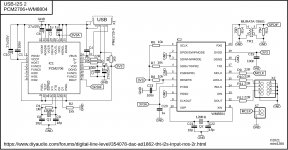 diyAudio_USB-I2S-2_Schematic.jpg391.7 KB · Views: 636
diyAudio_USB-I2S-2_Schematic.jpg391.7 KB · Views: 636 -
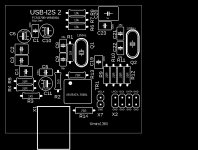 diyAudio_USB-I2S-2_Parts.jpg95.6 KB · Views: 617
diyAudio_USB-I2S-2_Parts.jpg95.6 KB · Views: 617 -
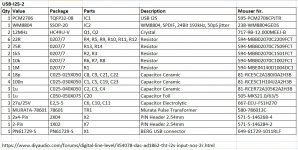 diyAudio_USB-I2S-2_BOM.jpg216 KB · Views: 558
diyAudio_USB-I2S-2_BOM.jpg216 KB · Views: 558 -
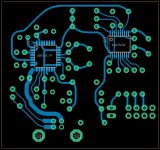 diyAudio_USB-I2S-2_Traces.jpg110.8 KB · Views: 476
diyAudio_USB-I2S-2_Traces.jpg110.8 KB · Views: 476 -
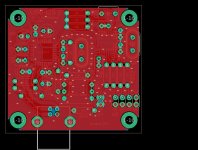 diyAudio_USB-I2S-2_GND.jpg164.4 KB · Views: 545
diyAudio_USB-I2S-2_GND.jpg164.4 KB · Views: 545
Hello can you point out what is the CM6631A USB to i2s board?Hi Miro,
any chance for a Cathrine DAC that would have the option for either totally usb power or external (i.e. good quality 5V) power? In this case one would be able to use this with a phone plus one 5V supply - for mobile use a powerbank would be sufficient.
I've recently acquired a cheap and small CM6631A USB to i2s interface board and used it together with Richards PhiDAC. PhiDAC is external powered, yet the interface is usb powered. Not only with my phone this DAC is really great for the 3$ BOM :-D (PhiDAC only - USB was 20 Euro). For Cathrine this interface might be a feasible option beside the pcm2706, you want to use for long time support.
Cheers, Ernst
I would like to try. Thks
I'm not sure if Ernst is talking about the usual CM6631A board I recommend, its this one on Taobao but has been out of stock of late : CM6631A USB?I2S???? ???? ?????Amanero XMOS DAC-???
USB board
Hi Richard, as I remember you recommended 2 different USB boards. The one you mentioned and one like this:
??Y10 CM6631A USB????I2S SPDIF??24Bit 192K 384K ASIO-???
I bought this one. It is available via aliexpress and ebay as well. 🙂
Cheers, Ernst
Hi Richard, as I remember you recommended 2 different USB boards. The one you mentioned and one like this:
??Y10 CM6631A USB????I2S SPDIF??24Bit 192K 384K ASIO-???
I bought this one. It is available via aliexpress and ebay as well. 🙂
Cheers, Ernst
Last edited:
Ah, thanks Ernst I'd forgotten I'd recommended more than one. I'm probably going to recommend this one again now that the first one's not readily available.
Hi Richard, as I remember you recommended 2 different USB boards. The one you mentioned and one like this:
??Y10 CM6631A USB????I2S SPDIF??24Bit 192K 384K ASIO-???
I bought this one. It is available via aliexpress and ebay as well. 🙂
Cheers, Ernst
i just bought it to try !!!
i have the jlsounds to compare.
Ernst, try some experiments with the external supply. I am curious what happens
 🙄
🙄Miro, I'll try a few things.
The recommended Y cable, in order to use clean power for the entire DAC. Yet I think, I will add a switch and a 5.5/2.5 mm powerinlet later. Seems to be more elegant for me. 🙂
Ernst, no sorry I don't know anything about the jitter numbers.
@pistollero - the JLsounds board has isolation right? I'd expect it to sound better because of that.
@pistollero - the JLsounds board has isolation right? I'd expect it to sound better because of that.
Yes it has.Ernst, no sorry I don't know anything about the jitter numbers.
@pistollero - the JLsounds board has isolation right? I'd expect it to sound better because of that.
- Home
- Source & Line
- Digital Line Level
- DAC AD1862: Almost THT, I2S input, NOS, R-2R
